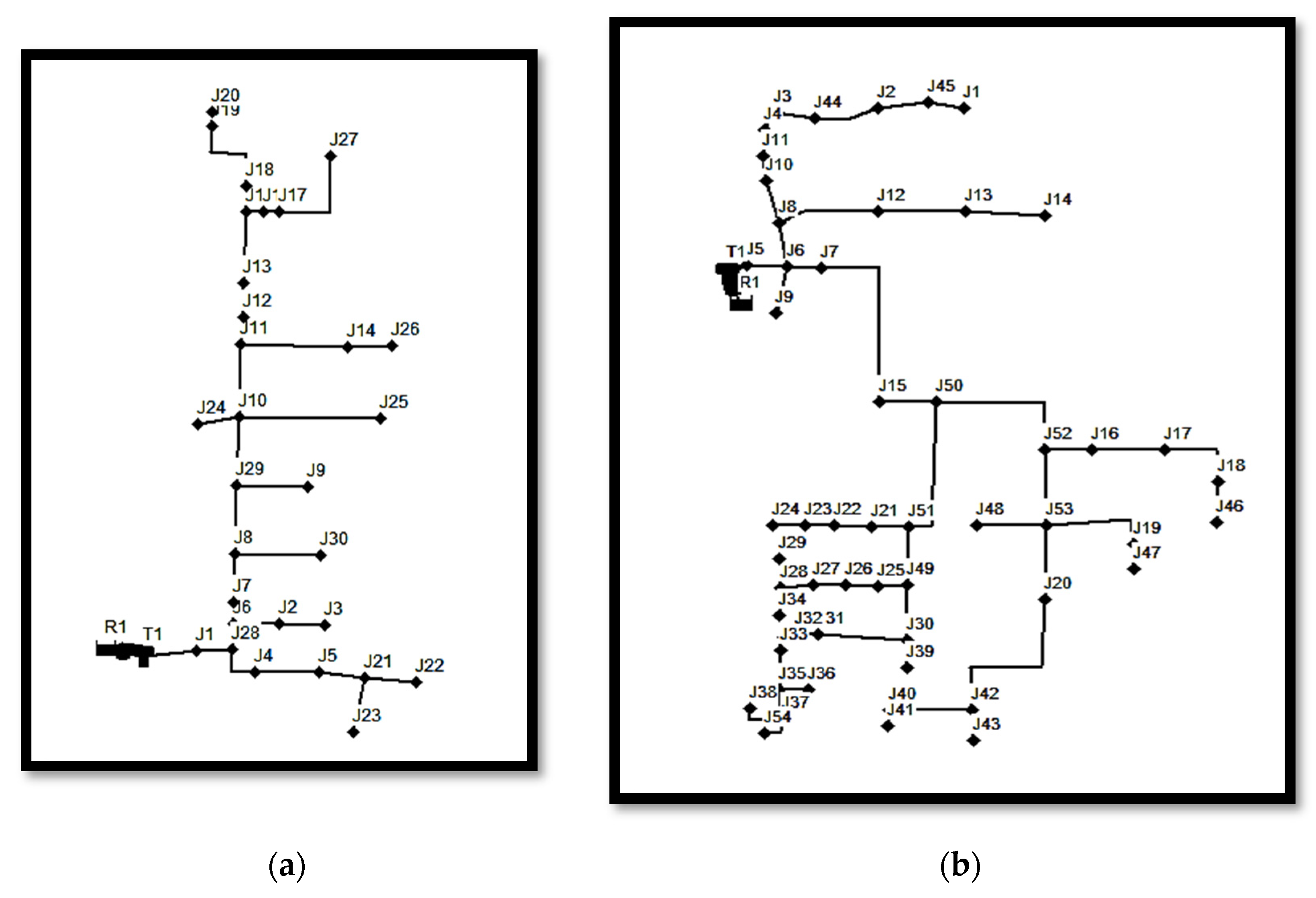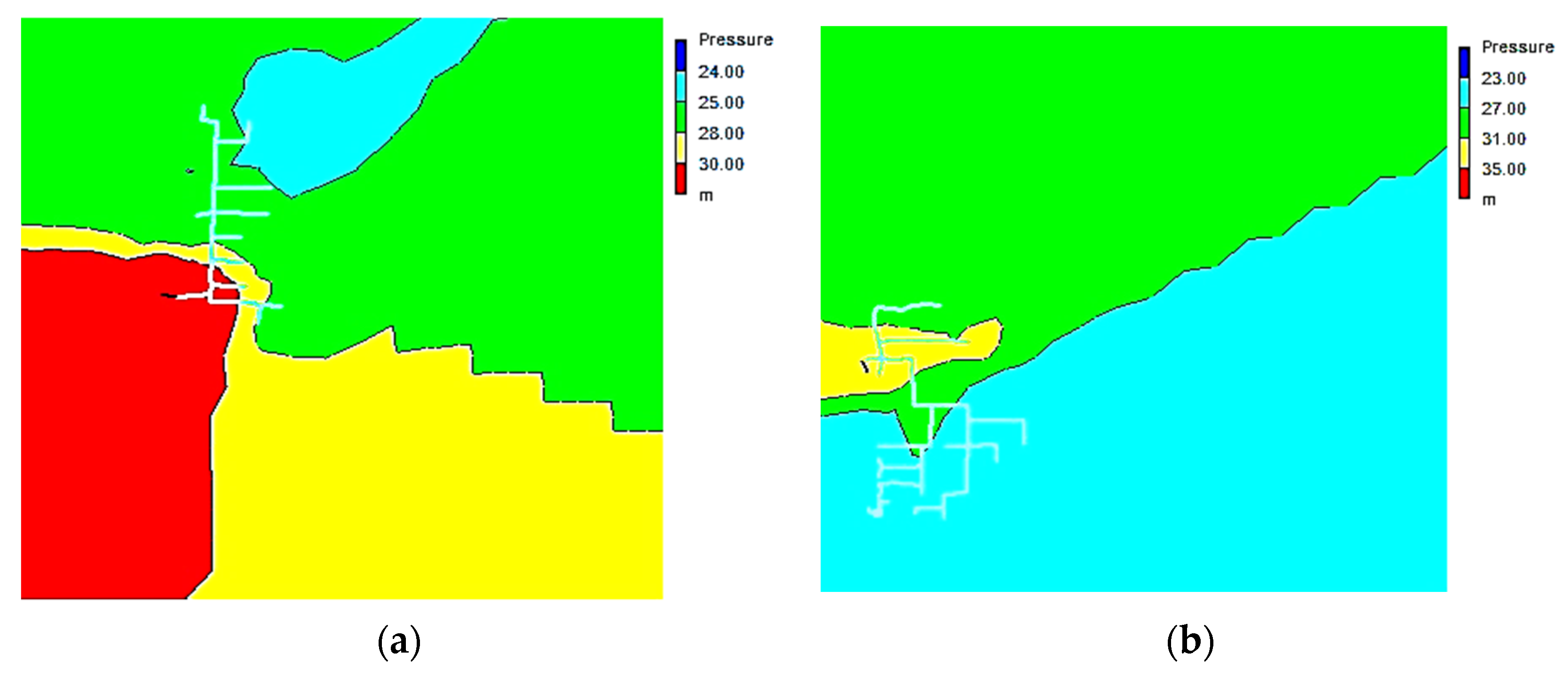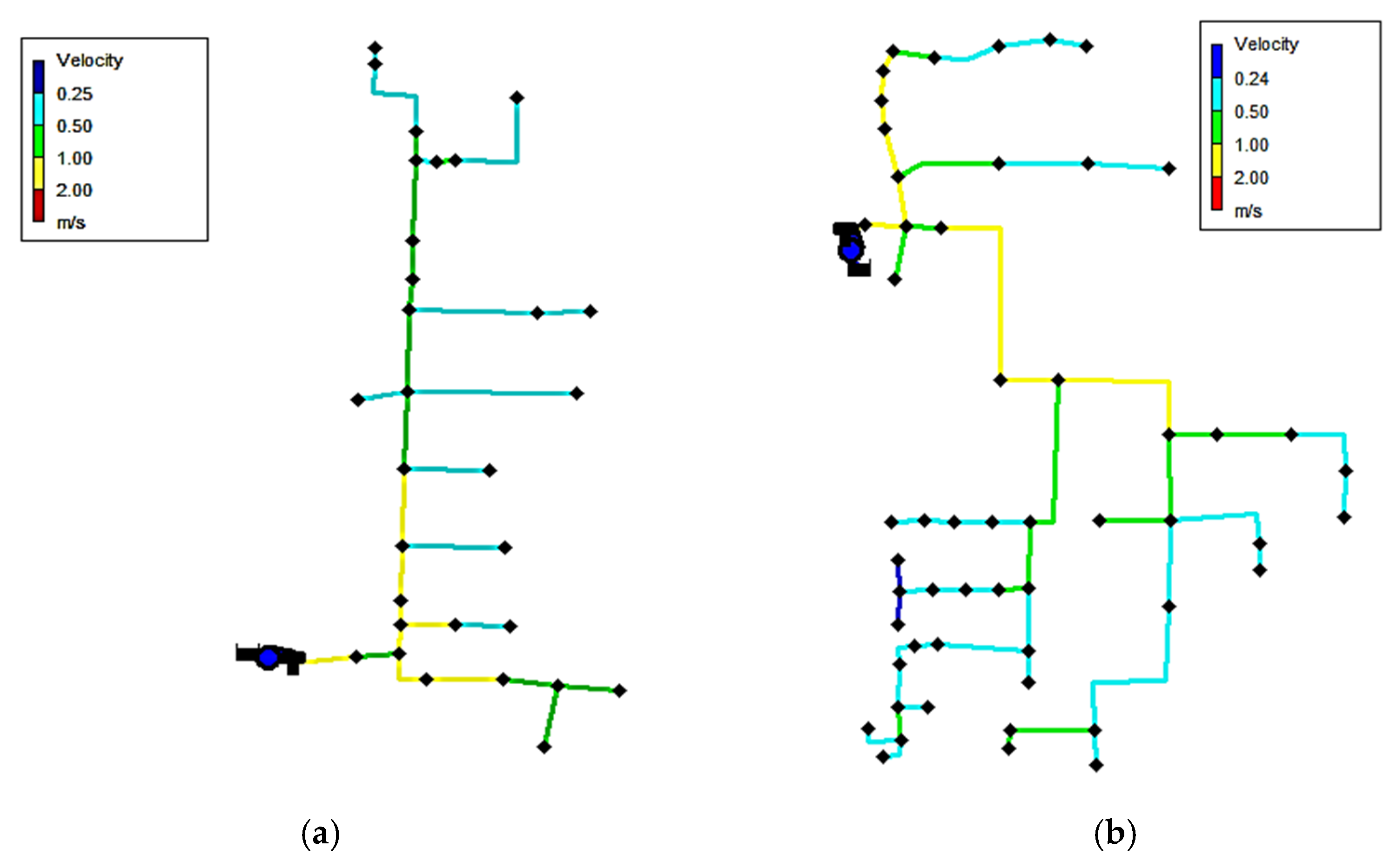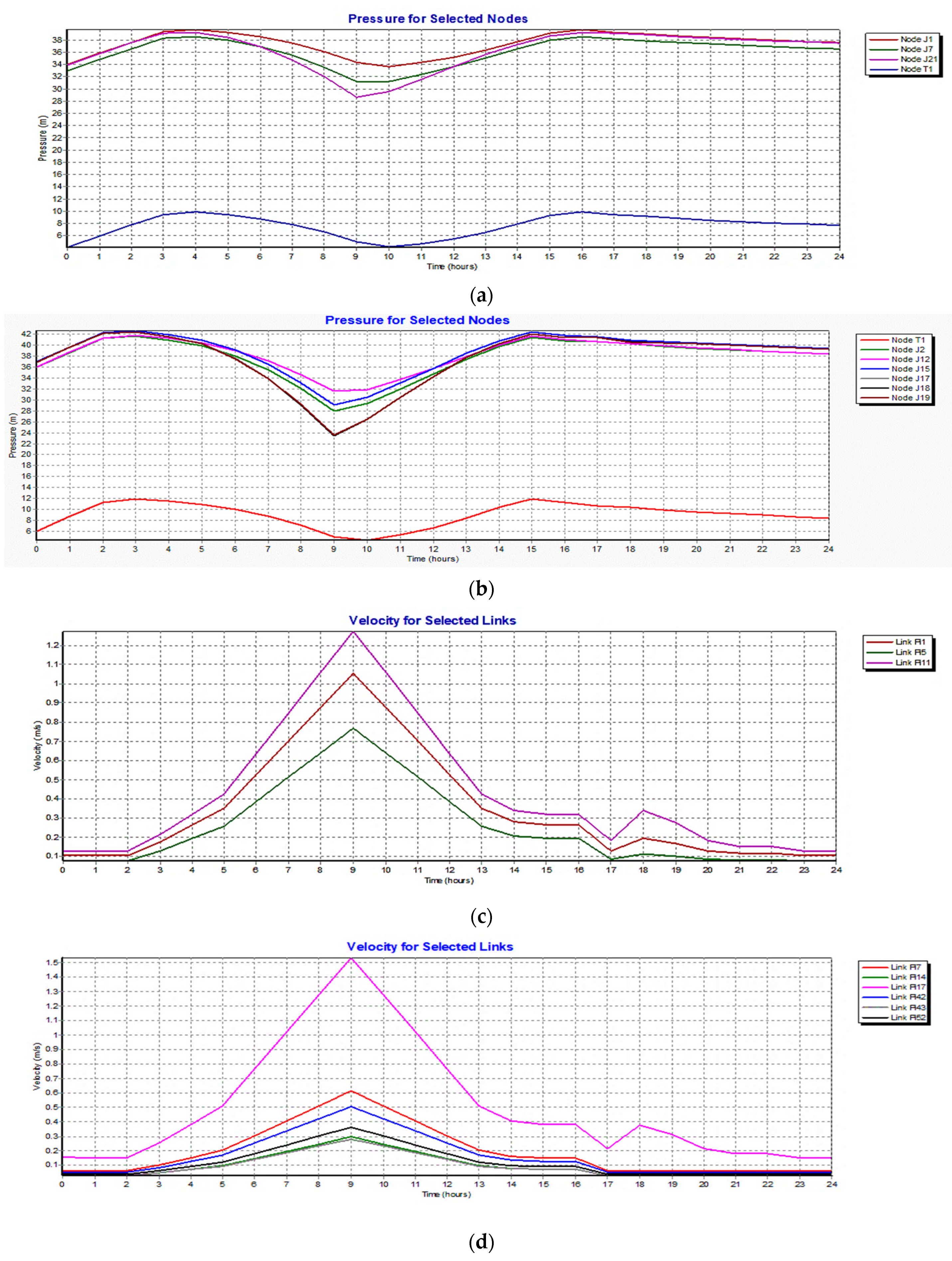Application of EPANET 2.2 Software and Jal-Tantra Web System for Optimal Hydraulic Design of Water Distribution System for University of Kashmir †
Abstract
:1. Introduction
2. Methodology
2.1. Study Area Description
2.2. Methodological Approach
2.3. Methods of Data Collection
2.4. Methods of Analysis
2.4.1. Evaluation of the EPANET 2.2 Input Parameters
2.4.2. Evaluation of the Technical Performance Indices (TPIs)
2.4.3. Input Parameters for the Jal-Tantra Web System
2.4.4. Optimization of the Hydraulic Model
- Pi = prevailing pressure head at the node.
- Vi = prevailing flow velocity in the pipe.
- H = staging height of the storage reservoir.
3. Results and Discussions
3.1. Distribution Network Layout
3.2. Contour Plan of Pressure Head at Nodes at 9 a.m. (Peak Demand Hour)
3.3. Colour-Coded Diagram of Velocity in Links at 9 a.m. (Peak Demand Hour)
3.4. Time Series Plots
3.5. Performance Evaluation by TPI
3.6. Cost Optimization by Jal-Tantra Web System
4. Conclusions
- The WDS is designed to have a minimum pressure head of 17 m at each node throughout the 24 h of a day, so that the water can reach up to a minimum of the third floor level of all the buildings. The pressure head at all the nodes in both parts of the network is such that 17 ≤ Pi ≤ 70 (m), indicating the absence of points of deficiency or excess in the pressure head in the network. As such, there is no need to install the pressure sustaining valves (PSV) or the pressure regulating valves (PRV), resulting in a further reduction in the capital cost of the network.
- The velocity of flow in all the pipes during the hours of maximum discharge is within the standard range of 0.25 ≤ Vi ≤ 3.0 (m/s), such that there is no danger of erosion or deposition during such hours. However, during the few hours of least discharge, the velocity of flow is less than 0.25 m/s in some pipes. Therefore, a scoring arrangement may be provided to remove the depositions, if any.
- The TPIs were evaluated for both parts of the WDS. The performance at peak hour with respect to pressure at nodes is 100%, while the performance with respect to velocity in pipes is 61.5% for WDS part I and 64.5% for WDS part II. The lower values of TPI velocity can be attributed to the lower values of velocity at off-peak hours due to the demand pattern adopted.
- Finally, the cost-optimality of the network was checked by using the Jal-Tantra web system, where the diameter of a few pipes was reduced by a maximum of 50 mm, while it increased by about 25 mm for a few pipes. The difference in the cost of the WDS as per EPANET modelling and that obtained by the Jal-Tantra is negligible, indicating the cost-optimal design of the WDS by EPANET.
Author Contributions
Funding
Institutional Review Board Statement
Informed Consent Statement
Data Availability Statement
Conflicts of Interest
References
- Awe, O.M.; Okolie, S.T.A.; Fayomi, O.S.I. Review of Water Distribution Systems Modelling and Performance Analysis Softwares Review of Water Distribution Systems Modelling and Performance Analysis Softwares. J. Phys. Conf. Ser. 2019, 1378, 022067. [Google Scholar] [CrossRef]
- Sonaje, N.P.; Joshi, G.M. A review of modeling and application of water distribution networks (wdn). Int. J. Tech. Res. Appl. 2015, 3, 174–178. [Google Scholar]
- Nagvekar, Y.; Pandri, Y.; Shinde, T.; Ukarde, A. A review study on use of epanet for water distribution networks. Int. J. Innov. Eng. Technol. 2019, 6, 42–44. [Google Scholar]
- Anisha, G.; Kumar, A.; Kumar, J.A.; Raju, P.S. Analysis and Design of Water Distribution Network Using EPANET for Chirala Municipality in Prakasam District of Andhra Pradesh. Int. J. Eng. Appl. Sci. 2016, 3, 53–60. [Google Scholar]
- Ramana, G.V.; Sudheer, C.V.S.S.; Rajasekhar, B. Network Analysis of Water Distribution System in Rural Areas using EPANET. Procedia Eng. 2015, 119, 496–505. [Google Scholar] [CrossRef]
- Siew, C.; Tanyimboh, T.T.; Seyoum, A.G. Penalty-Free Multi-Objective Evolutionary Approach to Optimization of Anytown Water Distribution Network. Water Resour. Manag. 2016, 30, 3671–3688. [Google Scholar] [CrossRef]
- Sharma, A.K.; Swamee, P.K. Cost considerations and general principles in the optimal design of water distribution systems. In Water Distribution Systems Analysis Symposium 2006; Buchberger, S.G., Clark, R.M., Grayman, W.M., Uber, J.G., Eds.; ASCE: Reston, VA, USA, 2012. [Google Scholar]
- Jacobs, H.E.; Strijdom, J.L. Evaluation of minimum residual pressure as design criterion for South African water distribution systems. Water SA 2009, 35, 183–191. [Google Scholar] [CrossRef]
- Kourbasis, N.; Patelis, M.; Tsitsifli, S.; Kanakoudis, V. Optimizing Water Age and Pressure in Drinking Water Distribution Networks. Environ. Sci. Proc. 2020, 2, 51. [Google Scholar] [CrossRef]
- Hooda, N.; Damani, O. JalTantra: A System for the Design and Optimization of Rural Piped Water Networks JalTantra: A System for the Design and Optimization of Rural Piped Water Networks. INFORMS J. Appl. Anal. 2019, 49, 1–12. [Google Scholar]
- Hooda, N.; Damani, O. Inclusion of tank configurations as a variable in the cost optimization of branched piped-water networks. Drink. Water Eng. Sci. 2017, 10, 39–44. [Google Scholar] [CrossRef]
- Bonora, M.A.; Caldarola, F.; Maiolo, M.; Muranho, J.; Sousa, J. The New Set Up of Local Performance Indices into WaterNetGen and Application to Santarém’s Network. Environ. Sci. Proc. 2020, 2, 18. [Google Scholar] [CrossRef]
- Muranho, J.; Ferreira, A.; Sousa, J.; Gomes, A.; Marques, J.A.S. Technical Performance Evaluation of Water Distribution Networks based on EPANET. Procedia Eng. 2014, 70, 1201–1210. [Google Scholar] [CrossRef]
- Avile, A.; Garcı, F. Pressure management for leakage reduction using pressure reducing valves. Case study in an Andean city. Alexendria Eng. J. 2019, 58, 1313–1326. [Google Scholar]
- Garg, S.K. Environmental Engineering (vol I); Khanna Publishers: Bangalore, India, 2010. [Google Scholar]
- Modi, P.N. Environmental Engineering (vol I); Standard Book House: Delhi, India, 2018. [Google Scholar]
- IS Code 1172: 1993—Code of Basic Requirements for Water Supply, Drainge and Sanitation; Bureau of Indian Standards: Old Delhi, India, 2002.
- CPHEEO Manual. Manual on Water Supply and Treatment. 1999. Available online: http://cpheeo.gov.in/cms/manual-on-sewerage-and-sewage-treatment.php (accessed on 22 September 2022).
- IS 9668: 1990—Provision and Maintenance of Water Supplies For Fire Fighting; Bureau of Indian Standards: Old Delhi, India, 2010.
- Rossman, L.; Woo, H.; Tryby, M.; Shang, F.; Janke, R.; Haxton, T. EPANET 2.2 User Manual; U.S. Environmental Protection Agency: Cincinnati, OH, USA, 2020. [Google Scholar]




| S NO | PARAMETER | WDS PART I | WDS PART II |
|---|---|---|---|
| 1 | Forecasted Residential Population | 5324 | 8066 |
| 2 | Forecasted Floating Population | 1030 | 1720 |
| 3 | Avg. Daily Demand (ADD) | 891,000 L | 1,350,270 L |
| 4 | Max Daily Demand (MDD) | 1,603,800 L | 2.43 × 106 L |
| 5 | Avg. Hourly Demand (AHD) | 37,125 L | 56,262 L |
| 6 | Max Hourly Demand (MHD) | 111,375 L | 168,786 L |
| 7 | Fire Demand | 216,000 L | 216,000 L |
| 8 | Coincident Draft | 1,107,000 L | 1,566,270 L |
| 9 | Base Demand Multiplier | 0.104 | 0.1 |
| S NO | PARAMETER | WDS PART I | WDS PART II |
|---|---|---|---|
| 1 | Total storage capacity of the OHT | 6.17 × 105 L/day | 8.24 × 105 L/day |
| 2 | Volume of the OHT | 617 m3 | 824 m3 |
| 3 | Height of the OHT | 10 m | 12 m |
| 4 | Diameter of the OHT | 9 m | 9.5 m |
| 5 | Discharge to be provided by the pump | 0.037 cumec | 0.056 cumec |
| 6 | Staging Height of the tank | 30 m | 30 m |
| 7 | Economical diameter of the rising main | 250 mm | 300 mm |
| 8 | Pressure head to be developed by the pump | 51 m | 53 m |
| 9 | Input power for the pump | 24.7 kW | 37.4 kW |
| 10 | Cost of electrical energy/day at Rs 5 per unit | 1482 rupees | 2245 rupees |
| 11 | Design flow rate of the pump | 1856 lpm | 2813 lpm |
| WDS Part I |
|---|
| link Pu1 closed if node T1 above 10 |
| link Pu1 open if node T1 below 4 |
| WDS Part II |
| link Pu1 closed if node T1 above 12 |
| link Pu1 open if node T1 below 6 |
| Network Name | WDS Part I | WDS Part II |
|---|---|---|
| Organization Name | UOK | UOK |
| Minimum Node Pressure | 17 | 17 |
| Default Pipe Roughness ‘C’ | 100 | 100 |
| Minimum Head loss per KM | 0.010 | 0.01 |
| Maximum Head loss per KM | 65.000 | 65.000 |
| Maximum Water Speed | 3.000 | 3.000 |
| Maximum Pipe Pressure | 70.000 | 70.000 |
| Number of Supply Hours | 24 | 24 |
| Source Node ID | 31 | 55 |
| Source Node Name | Tank (T1) | Tank (T1) |
| Source Elevation | 1624.00 | 1623.00 |
| Source Head | 1628.00 | 1629.00 |
| Diameter (mm) | Cost (Rs) |
|---|---|
| 15 | 123 |
| 20 | 155 |
| 25 | 225 |
| 32 | 281 |
| 40 | 320 |
| 50 | 439 |
| 65 | 553 |
| 80 | 712 |
| 100 | 1031 |
| 125 | 1392 |
| 150 | 1626 |
| 200 | 2760 |
| WDS Part I | |||
| Diameter | Length | Cost | Cumulative Cost |
| 20.00 | 93 | 14,444 | 14,444 |
| 32.00 | 367 | 103,197 | 117,642 |
| 40.00 | 170 | 54,397 | 172,038 |
| 50.00 | 117 | 51,578 | 223,617 |
| 65.00 | 146 | 80,596 | 304,212 |
| 80.00 | 166 | 118,212 | 422,424 |
| 100.00 | 198 | 203,939 | 626,363 |
| 125.00 | 125 | 174,683 | 801,046 |
| 150.00 | 327 | 531,218 | 1,332,264 |
| 200.00 | 98 | 270,342 | 1,602,606 |
| Total | 1807 | 1,602,606 | |
| WDS Part II | |||
| Diameter | Length | Cost | Cumulative Cost |
| 15.00 | 126 | 15,449 | 15,449 |
| 20.00 | 72 | 11,103 | 26,552 |
| 25.00 | 243 | 54,690 | 81,242 |
| 32.00 | 182 | 51,142 | 132,384 |
| 40.00 | 191 | 61,120 | 193,504 |
| 50.00 | 230 | 100,827 | 294,331 |
| 65.00 | 541 | 299,353 | 593,684 |
| 80.00 | 609 | 433,608 | 1,027,292 |
| 100.00 | 298 | 307,238 | 1,334,530 |
| 125.00 | 178 | 247,931 | 1,582,461 |
| 150.00 | 312 | 507,895 | 2,090,356 |
| 200.00 | 61 | 167,642 | 2,257,998 |
| Total | 3043 | 2,257,998 | |
Disclaimer/Publisher’s Note: The statements, opinions and data contained in all publications are solely those of the individual author(s) and contributor(s) and not of MDPI and/or the editor(s). MDPI and/or the editor(s) disclaim responsibility for any injury to people or property resulting from any ideas, methods, instructions or products referred to in the content. |
© 2023 by the authors. Licensee MDPI, Basel, Switzerland. This article is an open access article distributed under the terms and conditions of the Creative Commons Attribution (CC BY) license (https://creativecommons.org/licenses/by/4.0/).
Share and Cite
Ajaz, M.; Ahmad, D. Application of EPANET 2.2 Software and Jal-Tantra Web System for Optimal Hydraulic Design of Water Distribution System for University of Kashmir. Environ. Sci. Proc. 2023, 25, 83. https://doi.org/10.3390/ECWS-7-14234
Ajaz M, Ahmad D. Application of EPANET 2.2 Software and Jal-Tantra Web System for Optimal Hydraulic Design of Water Distribution System for University of Kashmir. Environmental Sciences Proceedings. 2023; 25(1):83. https://doi.org/10.3390/ECWS-7-14234
Chicago/Turabian StyleAjaz, Mominah, and Danish Ahmad. 2023. "Application of EPANET 2.2 Software and Jal-Tantra Web System for Optimal Hydraulic Design of Water Distribution System for University of Kashmir" Environmental Sciences Proceedings 25, no. 1: 83. https://doi.org/10.3390/ECWS-7-14234
APA StyleAjaz, M., & Ahmad, D. (2023). Application of EPANET 2.2 Software and Jal-Tantra Web System for Optimal Hydraulic Design of Water Distribution System for University of Kashmir. Environmental Sciences Proceedings, 25(1), 83. https://doi.org/10.3390/ECWS-7-14234






